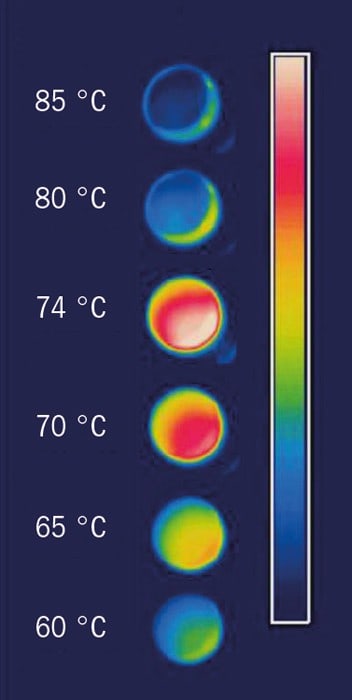
A special coating that can hide its own temperature from thermal cameras has been developed by researchers from the US. The technology relies on the temperature-dependant reflective properties of vanadium oxide, a material that undergoes extreme electronic changes at a specific temperature. When heated from room temperature to 80 °C, the material’s thermal radiation rises normally up until 74 °C, before suddenly appearing to drop to around 20 °C colder than in reality. The rather surprising result could have potential military applications, including camouflage, be used in communication systems and help with future metamaterial research.
When heated up from room temperature, vanadium oxide undergoes a transition from an insulating to a conductive, metallic state. At the same time, the material also changes from being almost transparent to infrared light to being reflective. This transition, however, does not occur instantaneously – and between these two end points, vanadium oxide behaves as a highly absorbing dielectric.
Thin films
Given this, when a thin film of vanadium oxide is placed on a highly reflecting substrate (for specific infrared wavelengths) such as sapphire, the film creates a combined structure that is either very absorbing or reflecting, dependant on the temperature. As these properties control the object’s thermal output, the structure therefore also has an emissivity that varies considerably with temperature. As a consequence, when the vanadium oxide transitions with increased temperature, the structure undergoes a sudden decrease in emissivity – looking colder to infrared cameras than it really is.
“Almost any known object emits light when it is heated. This ‘thermal radiation’ is responsible for the glow from a hot stovetop or light given off by an incandescent light bulb,” explains Mikhail Kats, who is a member of Federico Capasso’s group at Harvard University in the US. “We [have] demonstrated a structure that emits less light as it is heated over a certain temperature range – a very counter-intuitive effect,” he says.
Andrea Alù, an engineer at the University of Texas at Austin, who was not involved in the research, says that the technology “offers exciting possibilities to locally manipulate the emissivity of an object, in ways that we are not used to”. He also finds it “quite interesting that they achieved this effect without the need of patterning the layer or creating ad-hoc nanostructures but by simply using a thin uniform layer of a special phase-transition material”.
Applications galore
With their current research acting as a proof-of-concept, Capasso, Kats and colleagues believe that with minor modifications, potential applications for their new technology will be manifold. By varying the substrate materials to indium tin oxide, as one possibility, and modifying the vanadium oxide coating using doping, straining and other such processes, the researchers are hoping to be able to alter the wavelengths and temperature ranges at which the thermal effects are observed.
The team also rather fortuitously discovered that nanoscale structures that appear naturally in the transition region of vanadium oxide can be used to achieve a certain level of tunability, which in turn suppresses thermal radiation as the temperature rises. The team refers to such a spontaneously structured material as a “natural, disordered metamaterial”. Capasso points out that artificially creating such nanostructures within a material can be extremely difficult. “Here, nature is giving us what we want for free. By taking these natural metamaterials and manipulating them to have all the properties we want, we are opening up a new area of research, a completely new direction of work. We can engineer new devices from the bottom up,” says Capasso.
Doping the coating with tungsten, for example, would bring down the effect’s thermal range to room temperature. Such an altered coating could be used to passively camouflage a vehicle against thermal imaging cameras. Alternatively, different coatings could be used to create specific thermal beacons, for communication, more sensitive remote measurements with infra-red thermometers, or even surfaces on which “secret” messages could be left, like an infrared blackboard, by using a hot or cold probe to locally alter the emissivity.
Furthermore, as thermal emissions carry heat away from objects, the coating’s radiative properties could be used to deliberately speed up or slow down cooling – which could be used in a variety of structures from homes to space satellites. Kats and his colleagues are hoping to be able to develop prototypes to demonstrate some of these potential applications in the near future.
The work is published in Physical Review X.



